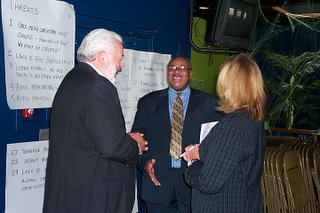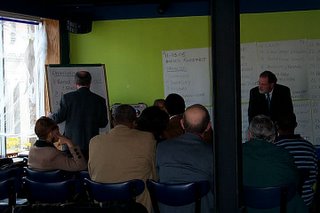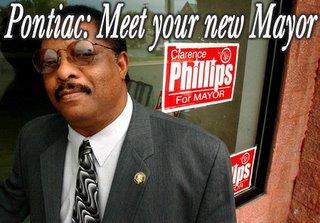Wednesday, November 09, 2005
Tuesday, November 08, 2005
Sunday, November 06, 2005
Blogging Indeed Is Here To Stay!
Blogging Is Indeed Here to Stay
October 31, 2005
By Chris Gonsalves
It was nearly a year and a half ago in this very space that my colleague Scot Petersen declared blogs "simultaneously mainstream and subversive" and, most assuredly, here to stay.
Though he wrote that "blogs have enabled the true democratization of the information age," I doubt that even he could have imagined how prophetic those words would seem at last week's BlogOn Social Media Summit in New York.
In fact, attendees—a collection of bloggers, blog management tool vendors and marketers dying to infiltrate the blogosphere—acknowledged that the blog alone is passé and the real interest is in the community-building nature of the new "social media."
Armed with a report showing some 90 percent of businesses surveyed say they want to incorporate blogging into their marketing efforts, BlogOn's organizer, the Guidewire Group, spent precious little time looking at where blogging has been and concentrated the discussion on where social media are going.
And where they're going is the mainstream, a place where social media are also finding some of their most passionate champions.
Old media insider Jeff Jarvis—a guy who has worked for New York Daily News, TV Guide and People; founded Entertainment Weekly; and now consults for The New York Times—is typical of blog converts and evangelists.
"The days of 'we own the community' are over," said Jarvis, taking a shot at the traditional media that employed him for decades. "We owned the free press for a century; now the people own it."
Jarvis made a point early on at BlogOn that became a theme for the show: the idea that marketers would be better served plugging into the blogging community rather than trying to control it.
"You don't own the community. You don't start the community," said Jarvis. "The very notion that you can start a community is ludicrous. A community is not a place where you go. Stop thinking you have a message to get out. Use the tools available to listen."
To leverage user communities, Bill Schreiner, vice president and general manager of Community Programming at AOL, also encouraged marketers to listen and to find the folks asking questions and sharing problems.
"Find out what they are saying, then talk to them," Schreiner said. "Those are your customers."
Schreiner, better known as the Love CEO for his leadership of Love@ AOL back in the mid-'90s, where he built the world's biggest online dating site, said it's the emerging technologies growing up around blogs, such as reader tagging and ranking, that are enabling communities to form.
Once you find them, Jarvis stressed, these voices need to be recognized for who they are, the influencers and thought leaders whom marketers claim to want to target.
Forget about who you know, he said. It's all about who they know.
"We think in old media terms, of an A-list," Jarvis said. "There is no A-list. Influencers are people who know people."
It's a little frightening for someone in the print press to hear a guy from the Old Gray Lady pushing alternate advertising, but Jarvis stressed his point by urging business attendees to buy ads on blogs "that are aimed at this targeted, passionate community."
Putting a finer point on it, Schreiner said key influencers within online communities often can be identified for the help they give others interested in a particular product or subject.
"Look for the people getting the thank-yous," he said. "Those are your thought leaders."
The comments at BlogOn match Guidewire's findings that "the next wave of adoption of social media tools will be driven by corporations who are adopting blogs for both internal and external communications at an increasing rate."
Or as Petersen predicted in May 2004: "The interactive nature of blogs gives bloggers and bloggees the sense that they are participating in something important and that they are making a difference."
Friday, November 04, 2005
City of Pontiac Leadership Discussion 11-3-2005


Leaders map city's strengths, threats
The Oakland PressPONTIAC -
Participants in a business round table Thursday morning rated Pontiac's main strengths as its "prime location" in Oakland County and the "people who care."
Other strengths rated highly include Pontiac's diverse ethnic groups, being part of the General Motors hub, having the rank of county seat, having a good health care infrastructure and its number of higher education institutes.
The round table was held on the mezzanine of Bo's Brewery and Bistro and was sponsored by the Committee of 50, a group of influential business and community leaders dedicated to assist in the revitalization of downtown.
Some of the innovative suggestions included one from the city's former Growth Group director, Frank Todd, who said city leaders should change Pontiac's name to "North Bloomfi eld." Todd said the name change would be part of an effort to improve the negative image of Pontiac that continues despite efforts to improve it.
He acknowledged there would be a lot of resistance to changing the name because people want to hang on to the old.
Todd also suggested all buildings downtown be given a face lift, even if they are empty, to make them more inviting.
Moderator Kevin Haezebroeck, president and publisher of The Oakland Press, asked participants to say what they saw as the city's strengths, weaknesses, opportunities and threats.
Both mayoral candidates - Mayor Willie Payne and state Rep. Clarence Phillips - were among those who contributed to the discussion. A list was made for each category and, at the end of the meeting, participants ranked them according to priority.
Ranked as the biggest weaknesses were economic issues, a negative perception regarding cleanliness and safety, voter apathy, vagrancy and homelessness, lack of jobs and the incomplete Strand Theater.
At the top among opportunities were community reinvestment programs, city and school partnerships, the Silverdome, Phoenix Plaza, the Strand Theater and partnerships with Oakland County.
Threats to revitalization that must be dealt with were cited, according to priority, as homelessness and vagrancy, lack of free parking, the perception that projects are not completed and the perception that the city is dependent on the auto industry.
Pontiac Northern High School senior Jeffery Triplett, the youngest person involved in the meeting, said many students today are required to do community service work, and he suggested they be called on to help as volunteers in the revitalization effort.
The committee will use this input as it continues with its work to help revitalize downtown, said the Rev. Doug Jones, chairman.
"We've got to make sure we keep the focus on it and make it happen," Jones said.
Haezebroeck said the ideas brought up at the meeting will be used because, "If it just dies on paper here, we're just wasting our time."


